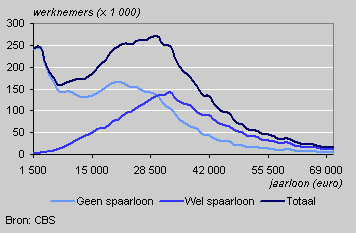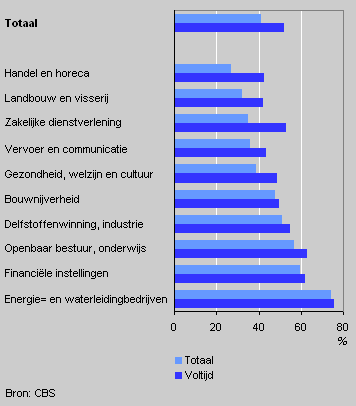Fewer participants in salary savings scheme

For the first time since the salary savings scheme was introduced in 1994, the number of participants decreased in 2003. When the maximum amount that could be saved annually in the salary savings scheme fell from 788 to 613 euro, participation also fell, i.e. by 2 percent points to 41 percent.
Participation in salary savings schemes

Mainly among full-timers and in the higher salary brackets
Over half of full-timers participate in salary savings schemes, whereas over one in three part-timers and only four percent of employees with a flexible contract do.
Participation in salary savings schemes appears to be dependent on wage level. One in eight employees earning an annual wage not exceeding 9,000 euro participate in salary savings schemes. Over half of employees earning more 30 thousand euro participate and so do over 70 percent of employees earning 48 thousand euro.
Salary savings participants per wage class of 1,500 euro, 2003

Participation per branch of industry
Most participants are found in the energy and water companies, where nearly three-quarters of all employees participate. Participation exceeds 50 percent in mining and quarrying and manufacturing industry, financial institutions, public administration and education. The lowest participation rates are found in agriculture and fisheries, trade and the sector hotels and restaurants.
Participation in salary savings scheme per branch of industry, 2003

Almost everyone saves the maximum amount
Participants in salary savings schemes on average saved more than 96 percent of the maximum amount in 2003. This means that most participants opt for the maximum amount they can save under the scheme. Since 1995 the average amount saved under the scheme has always been more than 90 percent of the maximum amount. Employees who started in 1994 with the maximum amount have now deposited over 7,400 euro in savings.
Wilmie Weltens and Johan Planting